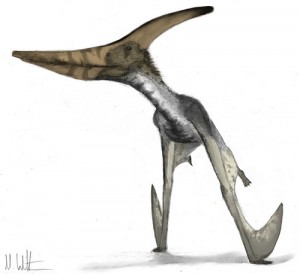November 18, 2010

A restoration of Pteranodon taking off by Mark Witton, lead author of the new PLoS One paper. Image from Mark Witton's Flickr page.
Earlier this week paleontologists Mark Witton and Michael Habib published a new study in
PLoS One on how pterosaurs—particularly large forms such as
Quetzalcoatlus—took to the air. Rather than pushing off the ground with their legs, pterosaurs used their arms in a pole-vault type of motion to launch themselves skyward. Interesting stuff, but I quickly became irritated by some of the popular coverage of the new research.
Whenever a story about pterosaurs makes it into mainstream news outlets, it is almost inevitable the flying archosaurs are going to be mistakenly called "dinosaurs" by at least one source. In this case the British newspaper the
Telegraph and the venerable
BBC were two of the main offenders, each declaring that pterosaurs were dinosaurs in their headlines.
It might be easy to brush off my complaint as a case of paleo-pedantry, but word choice matters. "Dinosaur" is a word for a specific group of creatures united by shared characteristics and which had their own evolutionary history—it is not a catch-all term for anything reptilian and prehistoric. Calling a pterosaur a dinosaur is an error of the same order of magnitude as saying that our species is a marsupial, but to understand why we need to flesh out the evolutionary relationships of these animals.
No comments:
Post a Comment